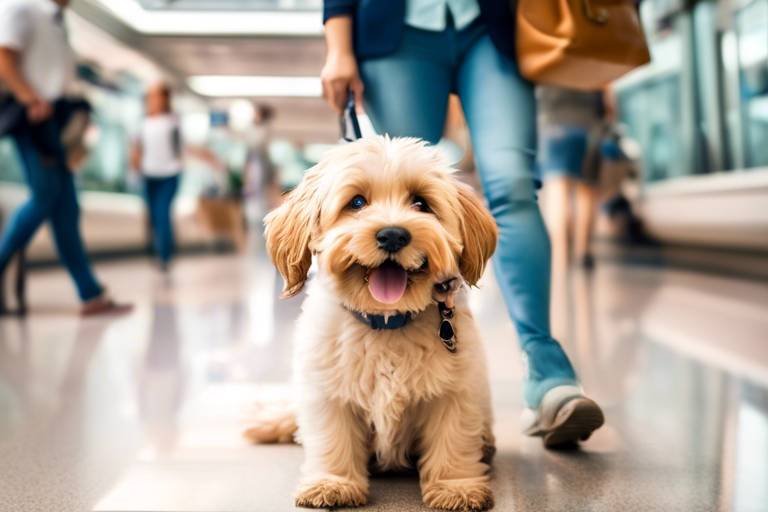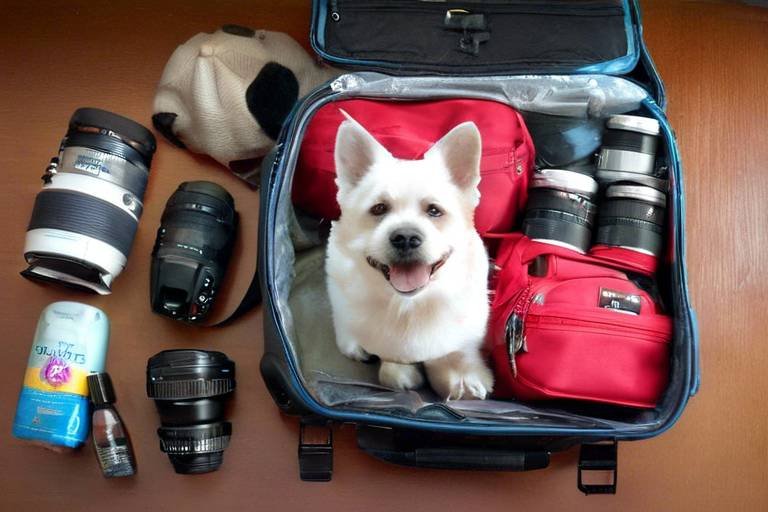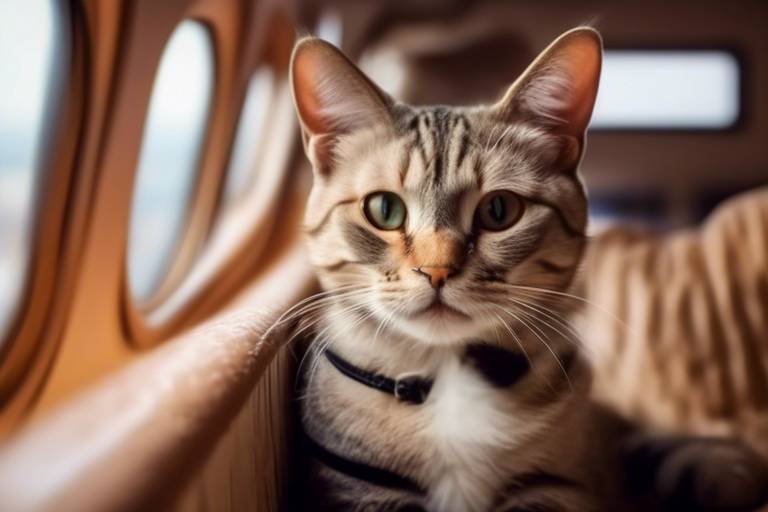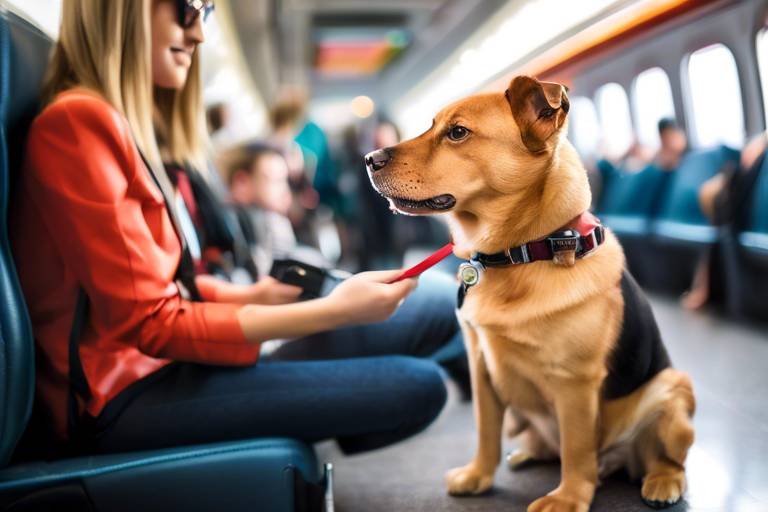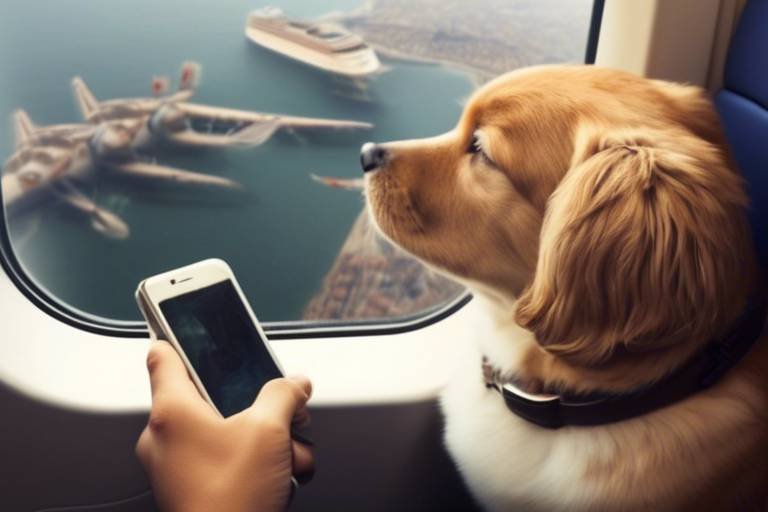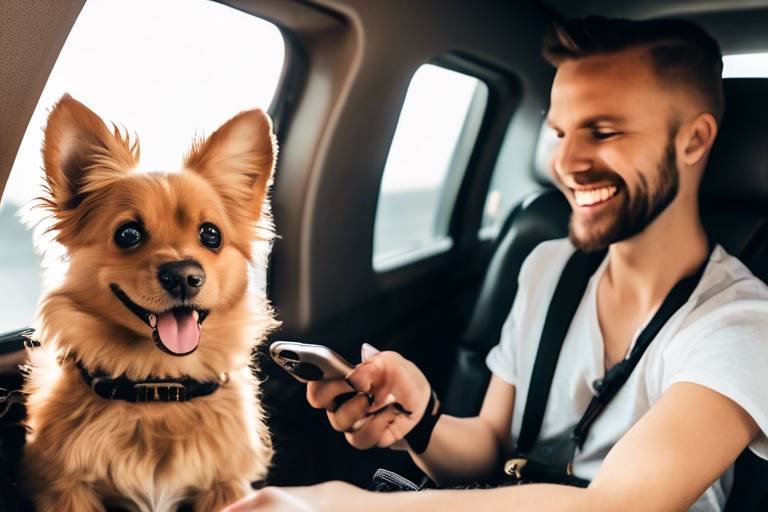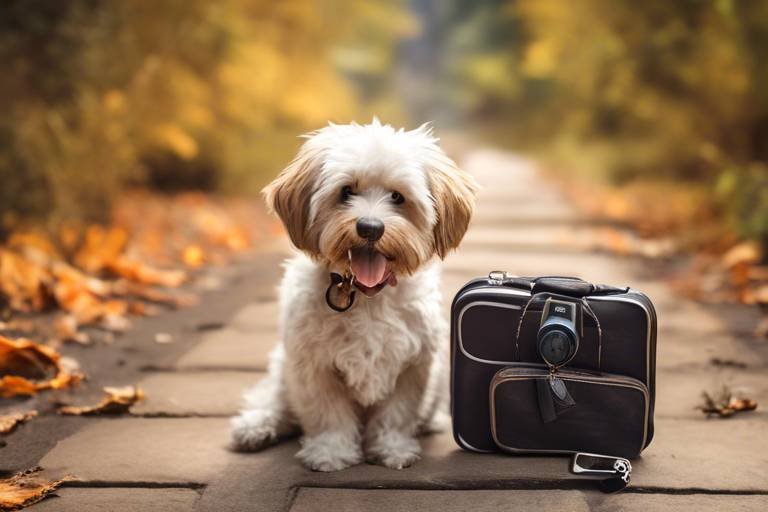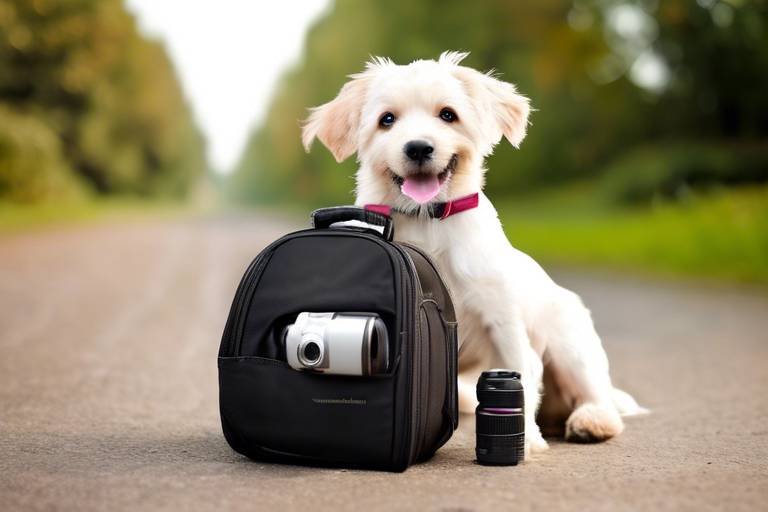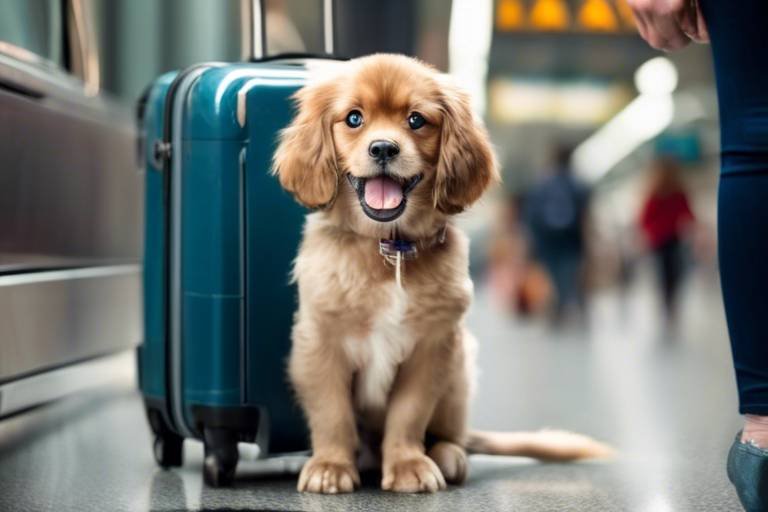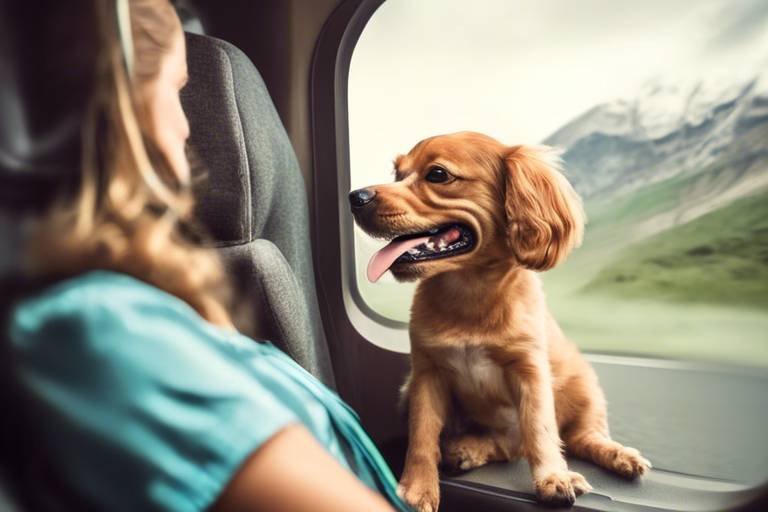How to Keep Your Pet Healthy During Summer Travel
Summer is a magical time filled with adventures, sunshine, and vacations, but it can also pose unique challenges for our furry friends. As pet owners, it's our responsibility to ensure that our pets stay healthy and happy while we explore new places. Whether you're heading to the beach, the mountains, or just a weekend getaway, there are essential tips and strategies you can employ to make your travels smooth and enjoyable for both you and your pet.
First and foremost, preparation is key. Imagine planning a road trip without checking your car's oil or tire pressure—it's a recipe for disaster! The same goes for your pet. Before you hit the road or board a plane, ensure your pet is up-to-date on vaccinations and has proper identification. This could be a microchip or a collar with an ID tag that includes your contact information. Don't forget to pack a travel bag for your pet that includes their favorite toys, food, water, and any medications they might need. Think of it like packing a mini suitcase just for them!
Choosing the right travel method can also make a world of difference. Are you driving or flying? Each option has its pros and cons. For instance, driving might give you more flexibility and comfort, allowing for frequent breaks to let your pet stretch their legs. On the other hand, flying can be quicker but may require more planning regarding crate sizes and airline policies. Assess your pet's temperament and health when making this decision—some pets thrive on the road, while others may feel more secure in a controlled environment like an airplane.
One of the most critical aspects of summer travel is keeping your pet hydrated. Just like us, pets can easily become dehydrated in the heat. Always carry a portable water bowl and offer them water regularly, especially during long stretches of travel. You can even freeze some water in a bowl for them to enjoy as it melts. This way, you’ll not only keep them hydrated but also provide a refreshing treat!
Heat exposure is another major concern during summer travel. Pets, especially those with thick fur, can suffer from heat exhaustion. Be vigilant and recognize signs like excessive panting, drooling, or lethargy. If you notice any of these symptoms, it’s crucial to act quickly by moving your pet to a cooler area and providing them with water. You can also use cooling mats or vests designed specifically for pets to help regulate their body temperature. Remember, just like we seek shade on a hot day, our pets need the same consideration.
Maintaining a healthy diet while traveling can be tricky, but it’s not impossible. It’s essential to keep your pet’s feeding schedule as consistent as possible. Consider packing portable food options that are easy to serve on the go. You might even want to bring along some of their favorite treats to reward them for being such great travel companions. If your pet is prone to an upset stomach, consult your vet about the best travel-friendly food options before you leave.
Finding pet-friendly accommodations is crucial for a stress-free trip. Not all hotels or rentals welcome pets, and it’s essential to do your research ahead of time. Websites like BringFido or Airbnb can be handy in finding places that will accommodate your furry friend. Look for amenities like pet-friendly parks nearby, as these can make your stay even more enjoyable. Think of it as a vacation for your pet too—after all, they deserve some fun in the sun!
Regular exercise is vital for your pet's physical and mental health, even while traveling. Incorporate walks or playtime into your itinerary. Whether it’s a morning stroll on the beach or an afternoon hike, these activities can help burn off excess energy and keep your pet happy. It’s a win-win situation—your pet gets to explore new surroundings while you both enjoy some quality time together.
Lastly, it's essential to recognize travel-related stress in your pet. Just like us, pets can feel anxious when faced with new environments or routines. Signs of anxiety can include whining, excessive barking, or even hiding. If you notice your pet showing signs of stress, try to create a calming environment by using familiar items, like their favorite blanket or toys. You can also consider calming aids, such as pheromone sprays or anxiety wraps, to help them feel more at ease.
After your adventure, don't forget to conduct a post-travel health check. Monitor your pet for any unusual behavior or signs of illness, such as changes in appetite or energy levels. If you notice anything concerning, it’s always best to consult your veterinarian. Just like we need time to recuperate after a trip, our pets do too!
- What vaccinations does my pet need before traveling? - Consult your veterinarian for specific vaccinations based on your destination and your pet's health.
- How can I keep my pet cool during travel? - Ensure proper ventilation in the vehicle, take regular breaks, and use cooling products designed for pets.
- Can I bring my pet on a plane? - Yes, but check the airline’s pet policy for crate specifications and any additional fees.
- What should I do if my pet gets car sick? - Talk to your vet about possible solutions, including medication or behavioral training.

Preparing Your Pet for Travel
Before you hit the road or take to the skies, is crucial. Think of it as packing your pet's suitcase, but instead of clothes, you're gathering all the essentials to keep them safe and comfortable. First things first, ensure that your furry friend is up-to-date on all necessary vaccinations. This is not just a formality; it's a way to protect them from diseases they might encounter in new environments. Consult your veterinarian to see if any additional vaccinations are required based on your travel destination.
Next, let’s talk about identification. Just like you wouldn’t travel without your ID, your pet should have proper identification as well. A collar with an ID tag that includes your contact information is a must. But don’t stop there! Consider getting your pet microchipped. This tiny chip can be a lifesaver if your pet gets lost in an unfamiliar place. Imagine the peace of mind knowing that your pet can be identified and returned to you, even if they slip out of their collar.
Now, let’s dive into the nitty-gritty of packing. You'll want to create a travel kit for your pet that includes:
- Food and Water: Bring enough of your pet's regular food to last the entire trip, along with portable water bowls. Keeping their diet consistent helps prevent any tummy troubles.
- Comfort Items: Pack their favorite blanket or toy. Familiar scents can help soothe anxiety during travel.
- First Aid Kit: A pet-specific first aid kit can be invaluable. Include items like bandages, antiseptic wipes, and any medications your pet may need.
- Leash and Muzzle: Always have a leash handy for bathroom breaks or unexpected stops. A muzzle might be necessary for certain situations, especially if your pet is nervous or reactive.
Finally, if your pet is not accustomed to travel, consider taking them on short trips before your big adventure. This way, you can gauge how they handle being on the move and make any necessary adjustments. Remember, the goal is to make your pet feel as comfortable and secure as possible, so they can enjoy the journey just as much as you do!

Choosing the Right Travel Method
When it comes to traveling with your furry friend during the summer, can make all the difference in ensuring a smooth and enjoyable journey. Whether you're planning a road trip or hopping on a plane, there are several factors to consider that will affect both your pet's comfort and safety. After all, a happy pet equals a happy trip!
First and foremost, consider your pet's personality and health. Some pets are natural adventurers, while others may feel anxious in new environments. If your pet tends to get car sick or is easily stressed, driving might be the best option. On the other hand, if your pet is calm and enjoys the thrill of travel, flying could be a fantastic way to reach your destination quickly.
When deciding between driving or flying, think about the duration of the trip. For shorter distances, a car ride can be a great bonding experience. You can make frequent stops to let your pet stretch their legs and relieve themselves. However, for longer distances, flying might save time, but it requires careful planning to ensure your pet's safety and comfort during the flight.
Next, consider the climate of your destination. If you're heading to a place with extreme temperatures, make sure to choose a method that allows you to control the environment. For example, while driving, you can adjust the air conditioning to keep your pet cool. In contrast, on a plane, you might not have as much control over the cabin temperature, so check with the airline about their pet policies and climate control measures.
Another critical aspect to consider is pet carrier regulations. If you decide to fly, familiarize yourself with the airline's requirements for pet carriers. Some airlines have specific dimensions and guidelines that must be followed for your pet to travel in the cabin. Ensure that your carrier is comfortable, well-ventilated, and large enough for your pet to stand, turn around, and lie down comfortably.
Here’s a quick comparison of the two travel methods:
| Travel Method | Pros | Cons |
|---|---|---|
| Driving |
|
|
| Flying |
|
|
Ultimately, the decision boils down to your pet's unique needs and your travel preferences. Always prioritize your pet's comfort and safety when making your choice. And don't forget to pack all the essentials—food, water, toys, and any medications your pet might need. A well-prepared pet is a happy pet, and that makes for a much more enjoyable travel experience!

Keeping Your Pet Hydrated
When it comes to summer travel, one of the most critical aspects of your pet's health is hydration. Just like us, pets can easily become dehydrated, especially in the heat. Imagine being stuck in a car with no water on a hot day; it’s uncomfortable and can even be dangerous! So, how can we ensure our furry friends stay hydrated while on the road? Here are some effective strategies to keep your pet sipping happily.
First and foremost, always carry a portable water bowl. You wouldn’t drink from a dirty cup, right? The same goes for your pet. A collapsible water bowl is perfect for travel, as it’s lightweight and can easily fit into your bag. Make it a habit to stop every couple of hours during your journey to offer your pet fresh water. Even if they seem uninterested, a little sip can go a long way in preventing dehydration.
In addition to offering water regularly, consider the temperature of the water. Pets, much like us, prefer their drinks cool, especially in the summer heat. You can keep your water cool by using insulated bottles designed for pets. These not only help maintain the temperature but also make it easy to dispense water when your pet is thirsty.
Moreover, keep an eye on your pet's behavior. If they seem lethargic or are panting excessively, it might be a sign that they need water. Always remember that pets can’t tell us when they’re thirsty, so it’s up to us to be vigilant. If you’re on a long trip, you might also want to consider adding hydrating foods to their diet. For example, canned wet food has a higher water content than dry kibble, making it a great option for travel. Just be sure to introduce any new food gradually to avoid tummy troubles!
Another great tip is to utilize ice cubes. Adding ice cubes to your pet's water bowl can make drinking more fun and refreshing for them. Some pets enjoy chewing on ice cubes, which can also help keep them cool. Just ensure that the ice isn't too large to pose a choking hazard. You can even freeze some low-sodium broth into ice cubes for a tasty treat that also hydrates!
Lastly, if you’re traveling to a particularly hot area, consider scheduling your travel times early in the morning or later in the evening when temperatures are cooler. This not only helps keep your pet comfortable but also reduces the risk of overheating. And don’t forget to take breaks! Regular stops allow your pet to stretch, relieve themselves, and, most importantly, drink water.
In summary, keeping your pet hydrated during summer travel is all about preparation and observation. With a little planning, you can ensure that your furry friend stays happy and healthy on the road. So, pack that water bowl, keep an eye on the temperature, and most importantly, have fun on your summer adventures!
- How often should I offer my pet water during travel? It's best to offer water every couple of hours, even if your pet doesn't seem thirsty.
- Can I give my pet ice cubes? Yes, ice cubes can be a fun and refreshing way to keep your pet hydrated, just ensure they are small enough to avoid choking.
- What signs should I look for to know if my pet is dehydrated? Signs include excessive panting, lethargy, dry gums, and a loss of skin elasticity.

Protecting Your Pet from Heat
Summer travel can be an exciting adventure for both you and your furry friend, but it also comes with its own set of challenges, especially when it comes to protecting your pet from the heat. Just like humans, pets can suffer from heat-related illnesses, which can be serious and even life-threatening. To keep your pet safe and comfortable during those sweltering summer days, it's essential to take proactive measures.
First and foremost, never leave your pet in a parked car, even for a few minutes. The temperature inside a vehicle can rise dramatically, reaching dangerous levels in a matter of minutes. For example, on a 70°F day, the temperature inside a car can soar to 100°F in just 20 minutes! If you must travel with your pet, always ensure they are safely secured in a well-ventilated area of your vehicle. Consider using a pet seatbelt or a travel crate to keep them secure while allowing for air circulation.
Another effective way to protect your pet from heat is to schedule your travel during cooler parts of the day. Early mornings or late evenings are typically less hot, making it easier for your pet to handle the journey. If you’re stopping for breaks, look for shaded areas where your pet can stretch their legs without overheating. Additionally, always have fresh water available to keep your pet hydrated. A collapsible water bowl is a great travel companion!
When you arrive at your destination, be mindful of the environment. If you’re going to be outdoors, provide your pet with a shaded area to rest. You can use a portable pet tent or simply find a spot under a tree. If your pet is panting excessively or seems lethargic, it might be a sign that they are overheating. Be vigilant for symptoms of heat exhaustion, which include:
- Excessive panting
- Drooling
- Weakness or lethargy
- Vomiting
- Bright red or pale gums
If you notice any of these signs, it's crucial to act quickly. Move your pet to a cooler place, offer them water, and apply cool (not cold) water to their body to help lower their temperature. If symptoms persist, seek veterinary attention immediately.
Lastly, consider investing in pet cooling products, such as cooling vests, bandanas, or mats. These can help regulate your pet's body temperature when the heat becomes overwhelming. Remember, your pet relies on you to keep them safe, so taking these precautions can make all the difference in ensuring a fun and healthy summer trip for both of you!
Q: How can I tell if my pet is overheating?
A: Signs of overheating include excessive panting, drooling, weakness, and bright red or pale gums. If you notice these symptoms, take immediate action to cool your pet down.
Q: What should I do if I suspect my pet has heat exhaustion?
A: Move your pet to a cooler area, provide them with water, and apply cool water to their body. If symptoms do not improve quickly, contact your veterinarian.
Q: Are certain breeds more susceptible to heat-related issues?
A: Yes, brachycephalic breeds (like Bulldogs and Pugs) and older pets are more prone to heat-related problems due to their compromised breathing and overall health.

Maintaining a Healthy Diet on the Road
Traveling with your furry friend can be a thrilling adventure, but it also comes with its challenges, especially when it comes to maintaining a healthy diet. Just like us, pets thrive on routine, and when that routine is disrupted, their health can suffer. So, how do you ensure your pet eats well while on the go? First off, packing the right food is essential. Consider bringing along their regular food in portable, resealable containers. This not only keeps it fresh but also makes it easy to measure out portions.
Additionally, you may want to explore high-quality, travel-friendly pet food options that are designed for convenience. Look for brands that offer dehydrated or freeze-dried meals; all you need to do is add water, and voila! You have a nutritious meal ready to go. This can be especially helpful during long stretches of travel when you might not have access to a full kitchen.
When planning your travel itinerary, don't forget to schedule regular meal times. It’s easy to get caught up in the excitement of the journey, but skipping meals can lead to an upset stomach or worse. Aim to feed your pet at the same times you would at home, adjusting for time zone changes if you’re traveling far. It’s also a good idea to keep a close eye on their water intake, as dehydration can sneak up on pets, especially in warmer weather.
Here’s a quick tip: consider packing some healthy snacks for your pet. Carrots, apple slices (without seeds), or specially formulated pet treats can keep their energy levels up and provide a nice distraction during long car rides. However, always check with your vet before introducing new foods, especially while traveling, to avoid any digestive surprises.
Another aspect to consider is the potential for travel-related stress, which can affect your pet's appetite. If you notice your pet is feeling anxious and not eating, try to create a calm environment during meal times. You might also want to consider bringing their favorite bowl or even a piece of your clothing to help them feel more at home.
Lastly, if you’re staying at hotels or campsites, it’s crucial to check if they have pet-friendly dining options or nearby stores where you can purchase your pet’s preferred food. This can save you from the hassle of finding suitable meals on the road.
| Food Type | Benefits | Considerations |
|---|---|---|
| Dry Kibble | Convenient, easy to store | Ensure it's the same brand your pet is used to |
| Dehydrated Food | Lightweight, nutritious | Requires water, may need time to prepare |
| Canned Food | Palatable, hydrating | Heavier, must be kept cool |
| Snacks | Easy to pack, keeps energy up | Moderation is key to avoid upset stomach |
In summary, maintaining a healthy diet for your pet while traveling is all about preparation and adaptability. By packing the right food, sticking to a schedule, and being mindful of your pet’s needs, you can ensure that your furry companion stays healthy and happy throughout your summer travels.
Q: Can I feed my pet human food while traveling?
A: While some human foods are safe for pets, it's best to stick to their regular diet to avoid digestive issues. Always consult your vet before introducing new foods.
Q: How can I encourage my pet to eat if they're stressed?
A: Create a calm environment during meal times, and try offering their favorite treats. If anxiety persists, consult your veterinarian for advice.
Q: What should I do if I run out of my pet's food while traveling?
A: Look for pet stores in the area or check if your accommodation has pet-friendly options nearby. Always have a backup plan in place.

Finding Pet-Friendly Accommodations
When it comes to summer travel, one of the most significant challenges pet owners face is finding pet-friendly accommodations. After all, you want your furry friend to feel just as welcome as you do! Imagine arriving at a beautiful destination only to find that your hotel has a strict no-pets policy. Talk about a buzzkill! To avoid this scenario, it’s essential to do your homework ahead of time.
First and foremost, consider using online platforms that specialize in pet-friendly lodging. Websites like BringFido and Pets Welcome offer extensive listings of hotels, motels, and vacation rentals that cater to pet owners. These platforms often include user reviews, which can give you insights into how accommodating a place truly is. You wouldn’t want to end up in a spot that claims to be pet-friendly but has a reputation for being unwelcoming to pets!
Another important factor to consider is the size and breed restrictions that some accommodations may impose. While a tiny Chihuahua might be welcome at many places, larger breeds could face limitations. Always check the specifics of the pet policy before making a reservation. Some hotels charge additional fees for pets, while others might offer special amenities like dog beds or treats. It’s worth asking about these perks, as they can make your stay even more enjoyable.
Location plays a crucial role too. If you’re traveling to a city, look for accommodations near parks or pet-friendly beaches. This way, you can easily take your pet out for walks or playtime without having to travel far. On the other hand, if you’re heading to a rural area, consider a cabin or farmhouse that allows pets. These types of accommodations often provide more space for your pet to roam and explore.
Don't forget to check the reviews from other pet owners. Websites like TripAdvisor and Yelp can provide a wealth of information about how accommodating a place truly is. Look for comments that specifically mention the pet experience, such as how the staff treated pets, the cleanliness of the area, and whether there were any nearby pet-friendly activities.
Finally, always call ahead to confirm the pet policy before your arrival. Sometimes, the information on the website may not be up to date, and a quick phone call can save you from potential headaches. Plus, it gives you a chance to ask any specific questions you may have regarding your pet’s stay.
In summary, finding the right pet-friendly accommodation can make or break your summer travel experience. By utilizing online resources, checking for size restrictions, considering location, reading reviews, and confirming policies, you’ll ensure a smooth and enjoyable trip for both you and your beloved pet.
- What should I look for in a pet-friendly hotel? Look for amenities like pet beds, food bowls, and nearby parks. Also, check if they have any breed or size restrictions.
- Are there usually extra fees for bringing pets? Yes, many hotels charge a pet fee, so be sure to inquire about this when booking your stay.
- How can I ensure my pet is comfortable in a new environment? Bring familiar items like their bed, toys, and food to help them feel at home.
- Can I leave my pet alone in the hotel room? It depends on the hotel's policy. Some may allow it, while others may not. Always check first!

Regular Exercise While Traveling
When it comes to traveling with your furry friend, keeping them active is just as important as ensuring they're well-fed and hydrated. Imagine this: you're on a road trip, and your pet is lounging in the backseat, looking out the window. While that may seem cute, it's crucial to remember that **regular exercise** is essential for your pet's physical and mental well-being, especially during the excitement of summer travel. Just like us, pets can get restless and anxious when cooped up for too long. So, how can you incorporate playtime and exercise into your travel itinerary? Let's dive into some practical tips!
One of the easiest ways to ensure your pet gets enough exercise is to plan for **frequent stops** during your journey. If you're driving, aim to take breaks every couple of hours. These breaks aren't just for you to stretch your legs; they are perfect opportunities for your pet to run around, sniff the grass, and relieve themselves. A quick game of fetch or a brisk walk can do wonders for their energy levels and mood. Not only does this keep them physically active, but it also helps them to feel more relaxed and less anxious about the journey ahead.
If you're flying to your destination, you might think that exercise is out of the question. However, many airports now offer pet relief areas where your furry friend can stretch their legs before boarding. Take advantage of these facilities! A short walk or some playtime before a long flight can make a significant difference in how your pet handles the travel experience. Additionally, once you arrive at your destination, make it a point to explore the area together. Whether it’s a local park, beach, or hiking trail, new environments are exhilarating for pets and provide ample opportunities for **exploration and exercise**.
Moreover, don't forget to pack some of your pet's favorite toys. These familiar items can serve as great motivators for play, even in unfamiliar surroundings. A simple tug-of-war game or a round of fetch with a favorite ball can help burn off excess energy and strengthen your bond while traveling. It's like bringing a piece of home along with you, making your pet feel more secure and comfortable.
Lastly, consider scheduling specific activities that involve exercise. For example, if you're visiting a pet-friendly destination, look for local dog parks where your pet can run freely and socialize with other dogs. You could also research pet-friendly hiking trails that allow you to enjoy nature together while giving your pet the exercise they need. Remember, a tired pet is a happy pet, and ensuring they get their exercise will lead to a more enjoyable trip for both of you!
In summary, maintaining your pet's exercise routine while traveling is vital for their health and happiness. By planning regular breaks, utilizing pet relief areas, packing their favorite toys, and scheduling fun activities, you can ensure your furry companion stays active and engaged throughout your summer adventure. So, what are you waiting for? Get out there and make some unforgettable memories with your pet!
- How often should I exercise my pet while traveling? It's recommended to take breaks every 2-3 hours for exercise and bathroom breaks.
- What are some fun activities to do with my pet while traveling? Consider visiting dog parks, going for hikes, or simply playing fetch in a safe area.
- How can I help my pet adjust to a new environment? Bring familiar toys and bedding to make them feel more comfortable in new places.
- What should I do if my pet shows signs of stress while traveling? Provide them with a quiet space, engage in calming activities, and consider consulting a vet for advice.

Recognizing Travel-Related Stress
Traveling can be an exhilarating experience for both you and your pet, but it can also lead to a fair amount of stress. Just like us, pets can feel anxious when they are in unfamiliar environments or when their routines are disrupted. So, how do you know if your furry friend is feeling the travel blues? It’s essential to be vigilant and recognize the signs of travel-related stress to ensure your pet remains happy and healthy during your adventures.
One of the most common indicators of stress in pets is a change in behavior. For instance, if your usually playful pup suddenly becomes withdrawn, it could be a sign that they are feeling overwhelmed. Similarly, if your cat, who typically enjoys car rides, starts to meow excessively or hides in the carrier, it might be time to reassess the travel situation. Other signs to watch for include:
- Excessive panting or drooling: This can indicate anxiety or discomfort.
- Shaking or trembling: A clear sign that your pet is feeling scared or uneasy.
- Loss of appetite: If your pet refuses to eat their favorite treats, it might be a sign of stress.
- Destructive behavior: Chewing or scratching at crates can indicate a high level of anxiety.
To help mitigate these stressors, consider creating a calming environment for your pet during travel. For example, bringing along their favorite blanket or toy can provide a sense of familiarity. Additionally, maintaining a consistent routine, as much as possible, can help ease their anxiety. If your pet is prone to travel-related stress, you might also want to consult your veterinarian about potential calming products or medications that could assist during your trip.
Remember, your pet relies on you to recognize their needs and feelings. By being attentive and proactive, you can make your summer travels enjoyable for both you and your furry companion. After all, a happy pet means a happy journey!
Q: What are the signs of travel-related stress in pets?
A: Signs include excessive panting, shaking, loss of appetite, and destructive behavior. Pay attention to any changes in your pet's usual demeanor.
Q: How can I help my pet feel more comfortable during travel?
A: Create a calming environment by bringing familiar items, maintaining a routine, and considering calming products or medications if necessary.
Q: Should I consult my veterinarian before traveling with my pet?
A: Yes, it's a good idea to discuss your travel plans with your veterinarian, especially if your pet has a history of anxiety or health issues.

Post-Travel Health Check
After an exciting summer adventure, it’s easy to get caught up in the post-trip euphoria and forget about your furry friend’s health. However, conducting a thorough is crucial to ensure your pet is feeling their best after all the hustle and bustle. Just as we might feel a bit off after a long journey, our pets can experience similar discomforts. So, what should you look for when you return home?
First and foremost, monitor your pet for any signs of illness or discomfort. This could include unusual lethargy, changes in appetite, or any gastrointestinal issues. Pets can pick up bugs or even minor injuries while exploring new environments, so it’s essential to keep an eye on their behavior. If your pet seems less active than usual or is showing signs of distress, it might be time to consult your veterinarian.
Next, check your pet's skin and coat. Traveling can expose them to different climates and environments, which might lead to skin irritations or allergies. Look for any unusual bumps, redness, or excessive scratching. If you notice anything concerning, don’t hesitate to reach out to your vet for advice. Additionally, if your pet has been swimming or playing in unfamiliar water, be sure to check their ears for any signs of infection, such as redness or a foul odor.
Another important aspect of the post-travel health check is to ensure your pet is up-to-date on their vaccinations. Traveling can expose pets to various diseases, especially if they interacted with other animals. Consult your vet to see if any additional shots are necessary based on your travel destinations. Keeping a record of your pet's vaccination schedule can help you stay organized and ensure they receive timely care.
Lastly, don’t forget to give your pet a little extra love and attention after your travels. They may be feeling a bit anxious or out of sorts, so a few extra cuddles and playtime can go a long way in helping them readjust. Remember, your pet relies on you for comfort and reassurance, especially after a change in routine.
- How long should I monitor my pet after traveling? It's recommended to keep a close eye on your pet for at least a week after returning from your trip.
- What signs indicate my pet needs to see a vet? Look out for persistent vomiting, diarrhea, extreme lethargy, or any unusual behaviors that last more than a day or two.
- Should I change my pet's diet after travel? If your pet experienced gastrointestinal issues during travel, consider consulting your vet about a temporary change in diet.
Frequently Asked Questions
- What vaccinations does my pet need before traveling?
Before hitting the road, it's essential to ensure your furry friend is up to date on their vaccinations. Common vaccinations include rabies, distemper, and Bordetella. Always check with your veterinarian to see if any additional shots are necessary based on your travel destination.
- How can I keep my pet hydrated during long trips?
Hydration is key, especially in the summer heat! Make sure to pack a portable water bowl and offer your pet water regularly. If they’re reluctant to drink, you can try adding a splash of low-sodium broth to their water or offer ice cubes to chew on.
- What are the signs of heat exhaustion in pets?
Heat exhaustion can sneak up on our furry pals. Watch for symptoms like excessive panting, drooling, weakness, or a rapid heartbeat. If you notice these signs, it's crucial to cool them down immediately and seek veterinary help if necessary.
- How do I maintain my pet's diet while traveling?
Keeping a consistent diet can be challenging on the go. Bring along your pet's regular food in portable containers and stick to their feeding schedule as closely as possible. Look for travel-friendly food options, like pre-packaged meals or dehydrated food, if you're running low.
- Are there any tips for finding pet-friendly accommodations?
Absolutely! Websites like Airbnb or BringFido can help you find places that welcome pets. Always call ahead to confirm their pet policies and check for any additional fees or restrictions. A little research can ensure a comfy stay for both you and your furry friend!
- How can I help my pet cope with travel-related stress?
Travel can be overwhelming for pets. To ease their anxiety, try bringing along familiar items like their favorite blanket or toys. Regular breaks during long trips can also help them stretch and relieve stress. If needed, consult your vet about calming supplements or medications.
- What should I do for a post-travel health check?
After your adventure, keep an eye on your pet's health. Look for any changes in behavior, appetite, or bathroom habits. A quick visit to the vet can help catch any potential issues early, especially if your pet has been exposed to new environments or other animals.



